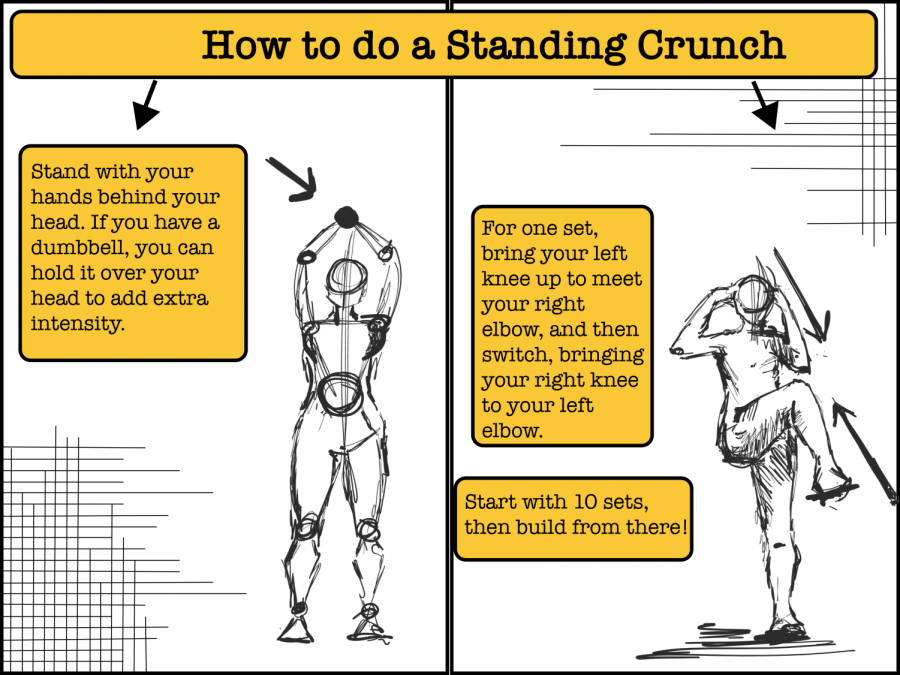Sitting all day? Get moving, trainer says
September 25, 2020
Do your neck and shoulders hurt from sitting at a computer for hours every day? Are you battling the “Quarantine-15” weight gain? Do you feel like you’ve grown roots in your desk chair?
Head trainer Amber Kelso, who works with AACC’s athletes, shared her top tips with Campus Current for students taking online classes.
Get physical
Kelso suggested “a brisk walk with your doggy or walking up the hills in your neighborhood.”
For students with bad knees, walking on a track is a good alternative for getting the recommended 150 minutes of moderate exercise each week.
“Some people only get a few thousand steps a day, and that’s just not enough,” she said. “That’s where all those extra pounds come from.”
Kelso also recommended doing muscle-strengthening exercises twice a week.
Don’t sit still
“It’s very important to get moving,” Kelso said, “even if it’s once an hour for 10 minutes, or once every half an hour for five minutes. Just get up, get moving”
Students who don’t have dogs to walk can “just get up and walk around the house,” she said.
She also suggested doing neck rolls and shoulder or arm circles to help combat stiffness from sitting in a desk chair for long periods.
And she especially recommended a standing crunch. “After you do like 10 of these bad boys, you get the blood pumping; you get some color back in your cheeks,” she said. You get a little ab contraction that you weren’t normally doing because most people sit slouchy and don’t engage their tummy at all.”
A standing crunch is like a sit-up, but done standing with hands on hips. For variation raise one knee to the chest and lower. Alternate knees.
Kelso calls it “such a good exercise, low impact, easy to do.” You stand up right next to your desk. You don’t need any room to do it and just get things moving again.”
Practice proper posture
Sitting all day requires “a good chair, good support, good posture,” Kelso said. “It starts with good alignment when you’re sitting.”
But she said there is no need to spend hundreds of dollars on a new ergonomic chair. Instead, she said, adding a pillow behind the lower back will help tilt the pelvis properly and engage the core muscles in the back and abdomen.
“Most people’s poor posture comes from a couple of things,” she said. “It’s a weak core, and we don’t engage our abs. If you don’t do it regularly, you actually have to reteach yourself to engage.”
She also cautioned against “tech posture,” which stretches and extends the back and neck, but tenses the upper back muscles and leaves the core unused. “It’s important to reverse that posture, head and chest up, you know, neck neutral, not flexed.”
Get creative
Kelso advised students on a tight budget who aren’t ready to brave crowds at the gym yet to find wallet-friendly solutions to add variety and intensity to home workouts.
“People were getting really creative in the beginning of quarantine,” she said. “They were making and selling concrete dumbbells because all the at-home exercise equipment was selling out. People were getting super creative.”
Kelso said weights aren’t needed for isometric exercises like squats, lunges, push-ups, wall-sits and plank poses.
A set of resistance bands can also help improve flexibility and strength regardless of age or physical ability, she said.
“Anyone from prepubescent to the elderly can do some light resistance bands,” she said.
Another alternative to visiting a gym or investing in expensive equipment is yoga, which relieves stress and improves strength and flexibility, Kelso said.
“The flexibility is awesome and challenging,” she said. “It feels so much better when you’re working on your flexibility compared to not putting any effort into it.”
AACC will offer noncredit, online yoga classes starting in October.












